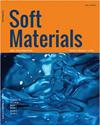Numerical investigation of electrohydrodynamic effect for size-tunable droplet formation in a flow-focusing microfluidic device
IF 1.4
4区 材料科学
Q4 MATERIALS SCIENCE, MULTIDISCIPLINARY
引用次数: 1
Abstract
ABSTRACT Droplet-based microfluidics has received much attention in biofabrication due to its compatibility with 3D printers that use cell-laden bioinks. In order to tailor the printing resolution, droplet generation under a DC electric field in a flow-focusing device is explored numerically. The major purpose of simulations is to investigate how geometry affects droplet production and electric field intensity. The effects of the orifice’s length, injection angle, and shape are discussed regarding the electric capillary number . Based on the retardation effect, the necking stage of droplet formation changes to expansion, and the frequency of droplet formation declines when the capillary number rises. For a particular value of the applied electric potential, orifice elongation reduces the induced electric field within the orifice. By adjusting the angle of side flow, smaller droplets can be formed, and the linear decrease in droplet size is provided across a wider range. The electric field in the orifice was amplified by 64% by creating a wedge-shaped orifice. In other words, when the notch angle was sharpened, the electric force increased, and the droplet diameter reduced. Since the frequency of droplet production varied only slightly between different notch angles, it could be preferable to generate smaller droplets without significantly altering the frequency of droplet formation.流动聚焦微流控装置中可调尺寸液滴形成的电流体动力效应数值研究
基于液滴的微流体由于其与使用细胞负载生物墨水的3D打印机的兼容性,在生物制造中受到了广泛的关注。为了调整打印分辨率,对流动聚焦装置中直流电场作用下的液滴生成进行了数值研究。模拟的主要目的是研究几何形状对液滴产生和电场强度的影响。讨论了孔板长度、注射角和形状对电毛细数的影响。基于阻滞效应,液滴形成由缩颈阶段转变为膨胀阶段,随着毛细数的增加,液滴形成的频率下降。对于施加电势的特定值,孔口伸长减小孔口内的感应电场。通过调整侧流的角度,可以形成更小的液滴,并在更大的范围内提供液滴尺寸的线性减小。通过制造楔形孔,将孔内电场放大了64%。也就是说,当缺口角变尖时,电场力增大,液滴直径减小。由于不同的缺口角度产生液滴的频率变化很小,因此在不显著改变液滴形成频率的情况下,最好产生较小的液滴。
本文章由计算机程序翻译,如有差异,请以英文原文为准。
求助全文
约1分钟内获得全文
求助全文
来源期刊

Soft Materials
工程技术-材料科学:综合
CiteScore
2.90
自引率
0.00%
发文量
21
审稿时长
2.2 months
期刊介绍:
Providing a common forum for all soft matter scientists, Soft Materials covers theory, simulation, and experimental research in this rapidly expanding and interdisciplinary field. As soft materials are often at the heart of modern technologies, soft matter science has implications and applications in many areas ranging from biology to engineering.
Unlike many journals which focus primarily on individual classes of materials or particular applications, Soft Materials draw on all physical, chemical, materials science, and biological aspects of soft matter. Featured topics include polymers, biomacromolecules, colloids, membranes, Langmuir-Blodgett films, liquid crystals, granular matter, soft interfaces, complex fluids, surfactants, gels, nanomaterials, self-organization, supramolecular science, molecular recognition, soft glasses, amphiphiles, foams, and active matter.
Truly international in scope, Soft Materials contains original research, invited reviews, in-depth technical tutorials, and book reviews.
 求助内容:
求助内容: 应助结果提醒方式:
应助结果提醒方式:


